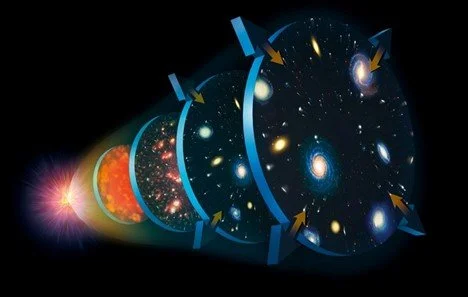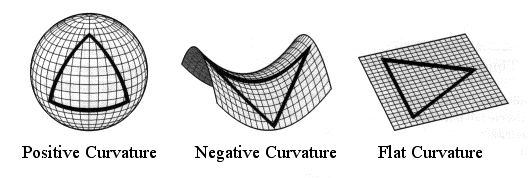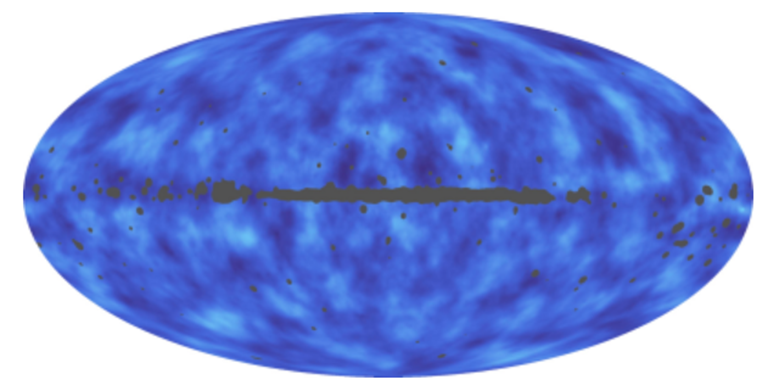The Shape of the Universe
Introduction
The shape of the universe can tell us about its past and its future. As Astronomy.com says “Whether the universe will expand forever or eventually collapse, and whether it’s finite or infinite— all are questions that tie back to its shape" [1]. The problem is, from where we stand, we may not be able to observe the true geometry of the wider universe because our view is confined to the boundary of the light that can reach us, known as the Particle Horizon, a fraction of the actual universe [2,3]. Our methods of measurement to determine the geometry of the universe are not infinitely precise, so a small curvature within their margin of uncertainty could point to an immense shape difference on a larger scale [1,4,5,6]. According to Astronomy.com, “The ultimate structure of the universe depends on just two factors: its density and its rate of expansion” [1]. So, what are the theories on the shape of our universe?
March 26, 2023
Figure 1: The Expansion of the Universe began with the Big Bang. Its expansion is still accelerating because of dark energy, although gravity (brown arrows) attempts to stop it [8].
Evidence of a Flat Universe
Up close, the geometry of the universe appears lumpy because of the distribution of stars and galaxies, but if we zoom out, it is relatively flat and even [1,2,3,4,5,7]. Our data on the universe’s density points to expansion without a curve [1,4,5]. A flat universe would mean that parallel lines would extend forever and remain forever parallel [7]. This universe would be infinite and expand in all directions forever, so it would have no defined edge [2,3,5,7,8,9]. But as our planet looks flat to us when we are standing on it, so might the observable curvature of the universe be so small that it is unnoticeable with the current precision of our measurements [2]. What if the small inconsistencies point to a larger trend?
Alternative Shapes
There are two possibilities for the shape of a universe with curvature. “If the universe's density is great enough for its gravity to overcome the force of expansion, then the universe will curl into a ball” [1,5] This positive curvature would indicate the Universe is a hypersphere, the 3D surface of a 4D sphere. In this universe, parallel lines would converge and cross as they travel around the universe and back to their starting point, forming a closed universe [1,2,3,4,7]. A theoretical ship trying to reach the edge of the universe would travel all the way around the hypersphere and end up back where it started [2,3]. “On the other hand, if the universe's density is low and unable to stop the expansion, space will warp in the opposite direction. This would form an open universe with negative curvature resembling a saddle” [1]. A universe with a negative curvature would be hyperbolic, forming a saddle shape. In this universe, two parallel lines would diverge and never meet again, forming an open universe[1,4,7,10].
Figure 2: Possible shape models of the Universe. From left to right: hypersphere, saddle, and flat [7].
Challenging the ΛCDM Cosmological Model
These shapes, however, are mostly theoretical. Most of our evidence points to a flat universe that aligns with our current universe model, the ΛCDM model [1,4,5]. This model takes into account six parameters that shape our universe, but it does not include a curvature, meaning it assumes a flat shape [1,4]. This theory was questioned in 2019 when the Planck telescope team released a paper claiming that variations in their Cosmic Microwave Background analysis could point to a universe with a curvature. They found much more gravitational lensing than is predicted by the ΛCDM model, indicating the universe has a higher density than previously thought [1,4,5,11]. Cosmic Microwave Background or CMB is the “afterglow of the Big Bang that radiates toward us from every direction”. Scientists measure temperature changes in these particles, “essentially performing trigonometry at the largest scale possible” [1]. The Planck team claims that the variations they found in their data do not align with the flat universe of the ΛCDM model, but with a closed one. Their point is not that our universe has a curvature, there is not enough data to support that theory when compared to the strong backing for the flat model, but that the ΛCDM model may need to be adjusted[1,4,5,12,13,14,15].
Figure 3: The Planck satellite’s 2015 CMB lensing potential data expressed as an all-sky map. The lighter regions correspond to over-densities and the darker regions show under-densities. The gray regions were masked in the analysis [12].
Takeaways
The shape of the universe will reveal its past and future, but for now, it remains a mystery. To better understand the density of the universe and its rate of expansion, we must continue refining our tools and moving closer to infinite precision [1,4,5,6]. Perhaps, we will never know the shape for sure. In the meantime, we’ll keep watching the stars.
Works Cited
[10] “‘Saddle-Shaped’ Universe Could Undermine General Relativity.” University of Cambridge, 22 May 2017, www.cam.ac.uk/research/news/saddle-shaped-universe-could-undermine-general-relativity#:~:text=Their%20predictions%20show%20that%20a. Accessed 27 Mar. 2023.
[12] “CMB Lensing.” Www.kicc.cam.ac.uk, 13 Jan. 2017, www.kicc.cam.ac.uk/research/cosmic-microwave-background-and-the-early-universe/CMB-lensing. Accessed 27 Mar. 2023.
[9] Baird, Christopher. “Where Is the Edge of the Universe?” Science Questions with Surprising Answers, 20 Jan. 2016, www.wtamu.edu/~cbaird/sq/2016/01/20/where-is-the-edge-of-the-universe/.
[8] Chown, Marcus. “Where’s the Edge of the Observable Universe? And What’s Beyond?” BBC Science Focus Magazine, 13 Oct. 2021, www.sciencefocus.com/space/the-universe-edge/.
[13] “CMB Lensing.” Background.uchicago.edu, background.uchicago.edu/~whu/cmblens/cmblens.html#:~:text=Large%20scale%20structure%20between%20the. Accessed 27 Mar. 2023.
[11] “ESA Science & Technology - What Are Baryonic Acoustic Oscillations?” Sci.esa.int, sci.esa.int/web/euclid/-/what-are-baryonic-acoustic-oscillations-#:~:text=Baryon%20acoustic%20oscillations%20(BAO)%20are.
[7] “Geometry of the Universe.” Abyss.uoregon.edu, abyss.uoregon.edu/~js/cosmo/lectures/lec15.html#:~:text=There%20are%20basically%20three%20possible.
[14] information@eso.org. “Gravitational Lensing.” Esahubble.org, esahubble.org/wordbank/gravitational-lensing/#:~:text=Gravitational%20lensing%20occurs%20when%20a.
[6] Sutter, Paul. “Is There Anything beyond the Universe?” Space.com, 2 May 2021, www.space.com/whats-beyond-universe-edge.
[15] Miller, Johanna. “Gravitational Lensing of the CMB.” Physics Today, 18 July 2011, physicstoday.scitation.org/do/10.1063/pt.4.0644/full/. Accessed 27 Mar. 2023.
[5] Rayne, Elizabeth. “What Is the Shape of the Universe?” Livescience.com, 13 Nov. 2022, www.livescience.com/what-is-shape-of-universe#:~:text=In%20this%20case%2C%20the%20WMAP. Accessed 27 Mar. 2023.
[3] “The Edge of an Infinite Universe.” YouTube, YouTube Video, 3 Apr. 2019, www.youtube.com/watch?v=tJevBNQsKtU. Accessed 25 Jan. 2020.
[1] Cottier, Cody | Published:, et al. “What Shape Is the Universe?” Astronomy.com, 23 Feb. 2021, astronomy.com/news/2021/02/what-shape-is-the-universe#:~:text=Most%20cosmological%20evidence%20points%20to.
[2] “What Happens at the Edge of the Universe? | Space Time | PBS Digital Studios.” Www.youtube.com, 2016, www.youtube.com/watch?v=AwwIFcdUFrE&t=473s. Accessed 27 Mar. 2023.
[4] Wolchover, Natalie. “What Shape Is the Universe? A New Study Suggests We’ve Got It All Wrong.” Quanta Magazine, 4 Nov. 2019, www.quantamagazine.org/what-shape-is-the-universe-closed-or-flat-20191104/.


